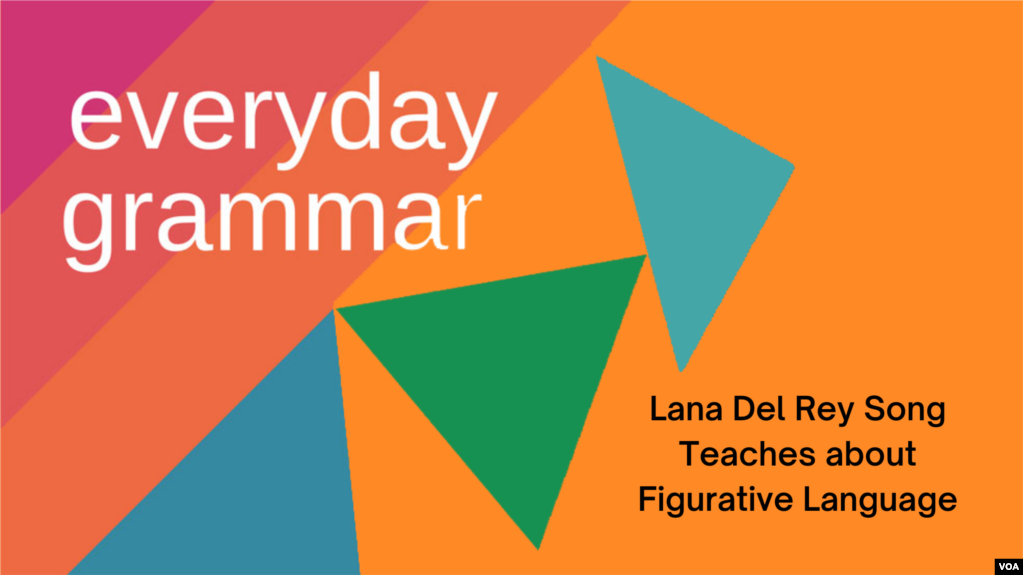
It has been 10 years since American music artist Lana Del Rey released Born to Die, the album that made her a star. Since then, the singer-songwriter has released six more records, including two within the last year.
Today on Everyday Grammar, we will explore the figurative language used in a song from Del Rey’s 2021 album, Blue Banisters. The song, Arcadia, is filled with similes, metaphors and even appositives as metaphors.
“My body is a map of LA
I stand straight like an angel, with a halo…
… In Arcadia, Arcadia
All roads that lead to you as integral to me as arteries
That pump the blood that flows straight to the heart of me
America, America…”
We can start by discussing some basic structures in similes, metaphors, and appositives.

Similes
You might have learned in an earlier report of Everyday Grammar that similes use the words “like” or “as” to describe an indirect comparison between two nouns. Similes can use linking verbs such as “to be.” Similes can also use the preposition “like” or the adverb “as” to make the comparison.
For example:
Her hair is golden like the sun.
In this example we use “is” as our linking verb and “like” as our preposition to describe her hair, comparing it to the golden color of the sun.
We could also use “as” for this sentence, but the meaning and structure is different.
Her hair is as golden as the sun.
We use the adverb “as” to make the comparison of the amount or level to which something is as something else.
Metaphors
Metaphors are comparisons using the linking verb “to be.” Since there is no preposition or adverb, the comparison between the two nouns is more direct.
Metaphors are still considered figurative language, so the meaning is not literal, even though there is a direct comparison.
Let us look at an example.
The vacation was a dream.
In this example, we are comparing the vacation to a dream. We use the linking verb “to be” in the past tense.
We know that the vacation was not a dream; it happened. This metaphor means that the vacation was really pleasurable or relaxing.
Appositives as metaphors
Appositives are nouns or noun phrases that go beside another noun (sometimes the subject) in a sentence to describe it.
For example, we can say:
Lana Del Rey, the famous singer, released two albums last year.
The appositive in this sentence is “the famous singer,” and it describes the subject, Lana Del Rey.
If we use commas around the appositive, the information is not necessary, but it creates more meaning. If we do not use commas, the information is necessary. We need it to understand the sentence fully.
The singer Lana Del Rey has sold millions of albums.
In this sentence, we need the appositive, Lana Del Rey, to know who the singer is. We do not need the commas.
Sometimes we can use the appositive structure to create a metaphor.
Let us use our previous metaphor to create an appositive metaphor structure:
The vacation, a dream, was so relaxing.
Here the metaphor is still the same, but we are using an appositive structure. The vacation is our subject, and the dream is the appositive. It is giving more information in a metaphorical way about the vacation.
Arcadia
Now let us look at the beginning of Del Rey’s song Arcadia, from her Blue Banisters album for metaphors, similes and appositives as metaphors.
“My body is a map of LA
I stand straight like an angel, with a halo…”
The first line of the song is a metaphor!
“My body is a map of LA…”
Lana compares herself to a map of Los Angeles, a city in California where she lives.
Note the linking verb “is.” It connects the subject to the rest of the metaphor.
In the next line, we can see that there is another structure we know, a simile.
“I stand straight like an angel, with a halo…”
Lana is comparing her posture, standing straight up, to an angel.
These two lines are connected because Los Angeles is known as the “city of angels.”
And finally, we have another simile and an appositive as a metaphor.
“In Arcadia, Arcadia
All roads that lead to you as integral to me as arteries
That pump the blood that flows straight to the heart of me
America, America…”
The simile, “All roads that lead to you as integral to me as arteries,” compares the roads that she travels on to the arteries that keep the blood moving in her body. She uses the adverb, “as” to describe that the roads are just as important to keeping her alive as the system of her heart and her arteries.
The appositive structure is not as clear based on the line structure, but from Lana singing the lyrics, we can understand that she is also comparing her heart to America.
“… to the heart of me America, America…”
Here the appositive of her heart and America act as a metaphor. She is saying her heart is America.
We know throughout many of Lana’s lyrics that “Americana” or American cultural ideas, is very important to her music.
Closing thoughts
Today, we looked at several kinds of figurative language in Arcadia. This song is filled with other similes that use the adverb “as” and preposition “like,” metaphors using the linking verb “to be,” and appositive structures.
Let us end this report with some homework. Listen closely to some favorite songs in English. Search for examples of similes, metaphors, or appositives and write them down. Then, play with the words! We think learning to use figurative language in English is always more fun with a soundtrack!
I’m Faith Pirlo.
Faith Pirlo wrote this lesson for VOA Learning English.
________________________________________________________________
Words in This Story
decade – n. a period of 10 years
Arcadia – n. a city in the US state of California near Los Angeles
banisters – n. handrails on stairs, steps, or a balcony
figurative – adj. abstract or symbolic, or not literal
similes – n. a phrase that uses the words like or as to describe someone or something by comparing it with someone or something else that is similar
metaphors – n. a word or phrase for one thing that is used to refer to another thing in order to show they are similar
appositives – n. nouns or noun phrases that go directly beside another noun (sometimes the subject) in a sentence to describe it.
angel – n. a spiritual being that serves especially as a messenger from God or as a guardian of human beings
halo – n. a circle of light that is shown in a religious painting, drawing, etc., around the head of a holy figure (such as an angel, saint, or god) — often used figuratively
integral – adj. necessary, important, or essential
arteries – n. large pathways in the body that help to move blood with oxygen from the heart throughout the body.
literal – adj. involving the ordinary or usual meaning of a word
relaxing – adj. restful and enjoyable
posture – n. the way in which your body is positioned when you are sitting or standing